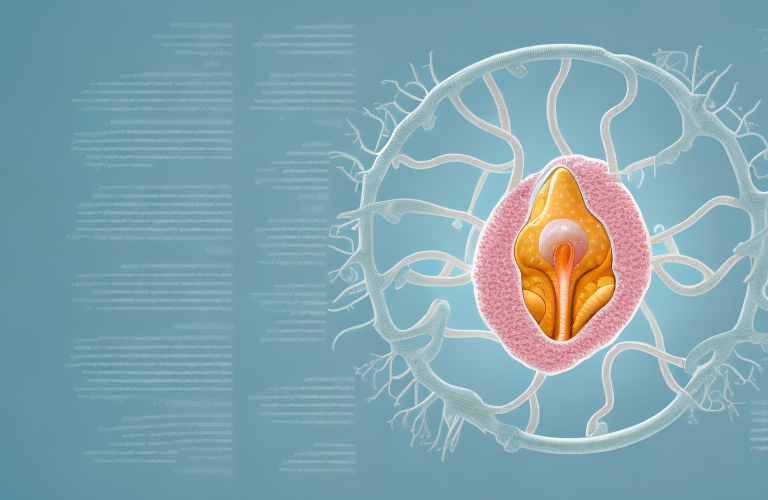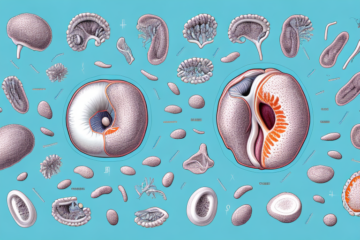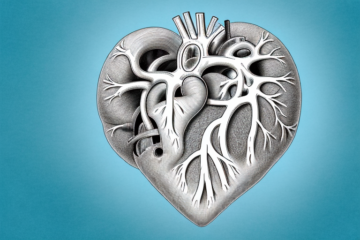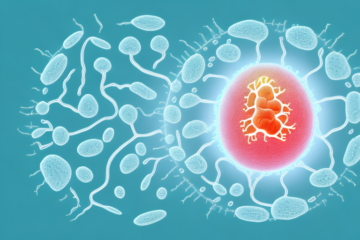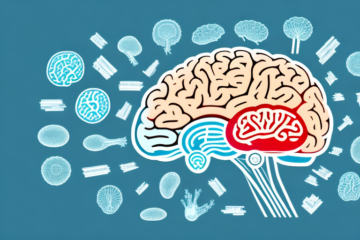If you’re experiencing itching, burning, or discomfort in your intimate region, it could be a sign of a vaginal yeast infection. This common condition affects about three out of four women at least once in their lifetime. In this article, we will discuss all you need to know about vaginal yeast infections including their symptoms, causes, treatment options, prevention tips, and more.
Understanding the basics of vaginal yeast infections
A vaginal yeast infection is an overgrowth of Candida in the vaginal area. Candida is a type of fungus that naturally lives in small amounts in your body, including your vagina. The overgrowth can cause inflammation, itching, and other uncomfortable symptoms.
There are several factors that can contribute to the development of a vaginal yeast infection. These include taking antibiotics, having uncontrolled diabetes, using hormonal contraceptives, and having a weakened immune system. It is important to identify and address any underlying causes to prevent recurrent infections.
Treatment for a vaginal yeast infection typically involves antifungal medications, either in the form of creams, suppositories, or oral tablets. It is important to complete the full course of treatment, even if symptoms improve, to ensure that the infection is fully cleared. Additionally, practicing good hygiene, wearing breathable clothing, and avoiding douching or using scented products in the vaginal area can help prevent future infections.
What are the common symptoms of vaginal yeast infections?
The most common symptoms of a vaginal yeast infection include:
- Itching or burning in the vagina and labia
- Thick and white vaginal discharge
- Pain during urination or sex
- Soreness and redness in the vagina and labia
If you experience any of these symptoms, it’s important to see your doctor to confirm if it’s a yeast infection and not something else.
It’s worth noting that some women may experience no symptoms at all, or very mild symptoms that go unnoticed. However, it’s still important to get regular gynecological check-ups to ensure that any potential infections or issues are caught early on.
How to diagnose a vaginal yeast infection
Your doctor will perform a physical exam and ask you about your symptoms. They may also take a sample of your vaginal discharge to examine under a microscope or send to a laboratory to confirm if it’s a yeast infection or not.
In addition to a physical exam and sample collection, your doctor may also ask you about your medical history and any medications you are currently taking. Certain medications, such as antibiotics, can increase your risk of developing a yeast infection.
If you have recurring yeast infections, your doctor may recommend additional testing to rule out underlying medical conditions, such as diabetes or a weakened immune system.
What causes vaginal yeast infections?
A vaginal yeast infection can be caused by a variety of factors:
- Taking antibiotics, which can kill off healthy bacteria and allow yeast to overgrow
- Pregnancy, which changes hormone levels and makes it easier for yeast to grow
- Diabetes or high blood sugar levels, which can feed the growth of yeast
- Using scented or irritating feminine hygiene products
- Spermicides, which can irritate the vagina
Other factors that can contribute to the development of a vaginal yeast infection include a weakened immune system, stress, lack of sleep, and a diet high in sugar and refined carbohydrates. It’s important to note that while yeast infections are common and usually not serious, they can be uncomfortable and cause symptoms such as itching, burning, and discharge. If you suspect you have a yeast infection, it’s best to see a healthcare provider for proper diagnosis and treatment.
Risk factors that increase your chances of getting a vaginal yeast infection
While anyone can get a vaginal yeast infection, certain factors can increase your risk:
- Using antibiotics
- Being pregnant
- Having uncontrolled diabetes
- Taking oral contraceptives
- Having a weakened or suppressed immune system
It is also important to note that certain lifestyle habits can also increase your risk of getting a vaginal yeast infection. These include:
- Wearing tight or non-breathable clothing
- Using scented hygiene products, such as soaps or sprays
- Frequent douching
- Eating a diet high in sugar and refined carbohydrates
- Having frequent or unprotected sex
If you are experiencing symptoms of a vaginal yeast infection, it is important to speak with your healthcare provider for proper diagnosis and treatment.
Prevention tips for vaginal yeast infections
To decrease your chances of getting a vaginal yeast infection:
- Wear cotton underwear and avoid tight-fitting clothing
- Avoid scented feminine hygiene products
- Keep your vaginal area clean and dry
- Change out of wet clothing or swimsuits right away
- Don’t douche
- Take probiotics or eat foods that contain probiotics (like yogurt) regularly
In addition to these prevention tips, it’s important to note that certain medications, such as antibiotics and steroids, can increase your risk of developing a vaginal yeast infection. If you are taking these medications, talk to your healthcare provider about ways to reduce your risk. It’s also important to seek medical attention if you experience symptoms of a yeast infection, such as itching, burning, or abnormal discharge, as untreated infections can lead to complications.
Natural remedies for treating vaginal yeast infections
While some natural remedies may provide temporary relief for yeast infection symptoms, it’s important to check with your doctor before using them:
- Garlic: Some people believe that placing a clove of garlic into the vagina can help fight off yeast.
- Tea tree oil: Applying diluted tea tree oil to the affected area may provide relief.
- Coconut oil: Some people claim that coconut oil can help reduce symptoms.
It’s important to note that while natural remedies may provide relief for some people, they may not work for everyone. Additionally, some natural remedies may cause irritation or allergic reactions in certain individuals. It’s always best to consult with a healthcare professional before trying any new treatment for a yeast infection.
Over-the-counter and prescription medications for treating vaginal yeast infections
There are many over-the-counter antifungal creams, suppositories, and tablets that can be used to treat vaginal yeast infections. Your doctor may also prescribe an oral antifungal medication if your infection is severe or recurring. It’s important to follow the instructions carefully and finish the full course of treatment as directed, even if your symptoms go away before you finish.
It’s important to note that while these medications can effectively treat yeast infections, they may not be suitable for everyone. Some individuals may experience side effects such as itching, burning, or irritation. Additionally, if you are pregnant or breastfeeding, it’s important to consult with your healthcare provider before using any medication to treat a yeast infection. They can help determine the best course of treatment for you and your baby’s safety.
Lifestyle changes that can help manage and prevent future vaginal yeast infections
Changing certain habits and behaviors can help prevent future yeast infections:
- Eating a healthy, balanced diet
- Wiping from front to back after using the bathroom
- Avoiding hot tubs and very hot baths
- Using unscented laundry detergent and avoiding fabric softeners
- Keeping diabetes under control
In addition to the above mentioned lifestyle changes, there are a few more things that can help manage and prevent vaginal yeast infections:
- Avoiding tight-fitting clothing, especially in the genital area
- Changing out of wet clothing, such as swimsuits or workout clothes, as soon as possible
- Using a mild soap to clean the genital area
- Avoiding douching or using scented feminine hygiene products
- Practicing safe sex by using condoms
The link between diet and vaginal health
While more research is needed, some studies suggest that what you eat can impact your vaginal health. Eating a diet rich in probiotics and anti-inflammatory foods may help prevent yeast infections. It’s important to talk to your doctor or a registered dietitian before making any major dietary changes.
In addition to diet, other factors such as hygiene practices, sexual activity, and hormonal changes can also affect vaginal health. It’s important to maintain good hygiene habits, such as wiping front to back after using the bathroom and avoiding douching. Using condoms during sexual activity can also help prevent the spread of sexually transmitted infections. Hormonal changes during pregnancy, menopause, and menstruation can also affect vaginal health, so it’s important to talk to your healthcare provider about any concerns or changes you may be experiencing.
How to avoid recurrent vaginal yeast infections
If you experience recurring yeast infections, your doctor may recommend a longer course of treatment or to switch to a different medication. They may also recommend taking a probiotic supplement or making lifestyle changes. It’s important to check with your doctor for advice on how to prevent recurrent infections.
One lifestyle change that can help prevent recurrent yeast infections is to avoid wearing tight-fitting clothing, especially in the genital area. This can create a warm and moist environment that promotes the growth of yeast. Instead, opt for loose-fitting clothing made from breathable fabrics like cotton.
Another way to prevent recurrent yeast infections is to avoid using scented products in the genital area, such as scented tampons or pads, douches, and sprays. These products can disrupt the natural balance of bacteria and yeast in the vagina, making it easier for yeast to grow and cause an infection.
Vaginal yeast infections during pregnancy: what you need to know
Pregnant women are more prone to developing a yeast infection due to hormonal changes and elevated blood sugar levels. It’s important to get treatment for a yeast infection during pregnancy to avoid complications. Over-the-counter antifungal medications can be used in pregnant women after consulting with a doctor.
Some common symptoms of a yeast infection during pregnancy include itching, burning, and a thick, white discharge. It’s important to note that these symptoms can also be indicative of other vaginal infections, so it’s important to see a healthcare provider for an accurate diagnosis. Additionally, practicing good hygiene, wearing breathable clothing, and avoiding douching can help prevent yeast infections during pregnancy.
When to see a doctor for a suspected vaginal yeast infection
If you suspect that you have a vaginal yeast infection and over-the-counter treatments aren’t working, it’s important to see your doctor. Other conditions like bacterial vaginosis or sexually transmitted infections can mimic yeast infection symptoms and require different treatments. If you have a fever or notice any unusual discharge, you should also see your doctor right away.
Being aware of the symptoms, causes, treatment options, and prevention tips for vaginal yeast infections can help you manage this common condition and live a comfortable life without experiencing the discomfort of recurring yeast infections.
It’s also important to note that certain lifestyle factors can increase your risk of developing a vaginal yeast infection. These include wearing tight clothing, using scented hygiene products, and taking antibiotics. If you experience frequent yeast infections, your doctor may recommend making changes to your lifestyle or prescribing a longer-term treatment plan to prevent future infections.

